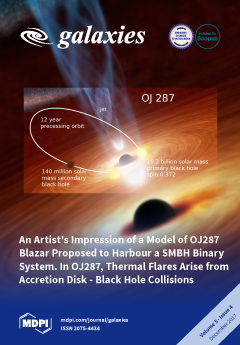Open AccessFeature PaperArticle
Behaviour of the Blazar CTA 102 during Two Giant Outbursts
by
Valeri M. Larionov, Svetlana G. Jorstad, Alan P. Marscher, Paul S. Smith, Sergey Savchenko, Daria Morozova, Tatiana Grishina, Evgenia Kopatskaya, Liudmila Larionova, Elena Larionova, Anna Mokrushina, Ivan Troitsky, Yulia Troitskaya and George Borman
Cited by 7 | Viewed by 3962
Abstract
Blazar CTA 102 underwent exceptional optical and high-energy outbursts in 2012 and 2016–2017. We analyze its behaviour during these events, focusing on polarimetry as a tool that allows us to trace changes in the physical conditions and geometric configuration of the emission source
[...] Read more.
Blazar CTA 102 underwent exceptional optical and high-energy outbursts in 2012 and 2016–2017. We analyze its behaviour during these events, focusing on polarimetry as a tool that allows us to trace changes in the physical conditions and geometric configuration of the emission source close to the central black hole. We also use
Fermi -ray data in conjunction with optical photometry in an effort to localize the origin of the outbursts.
Full article
►▼
Show Figures





